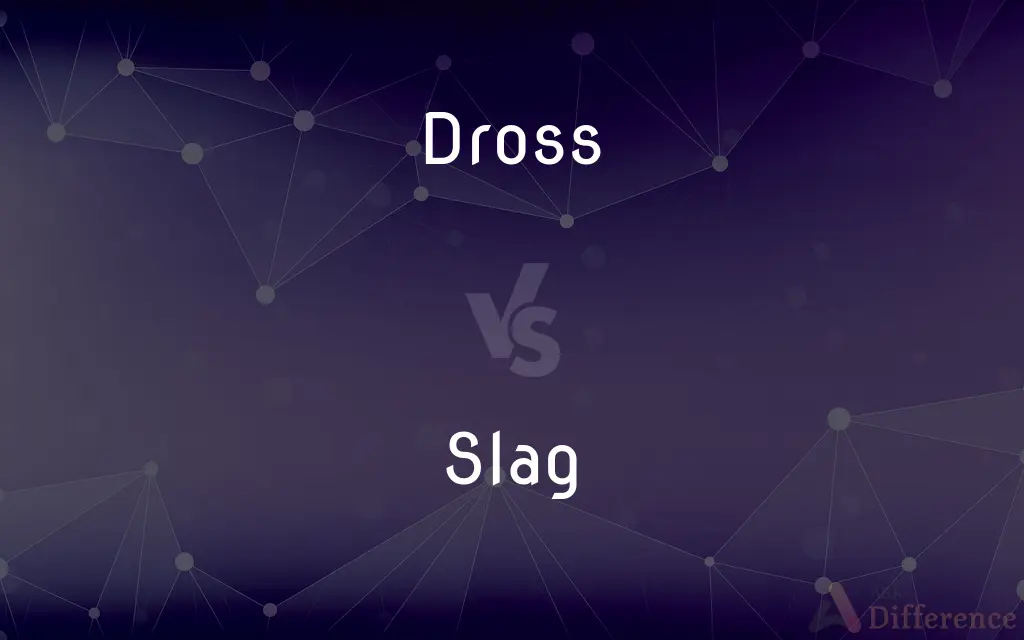Dross vs. Slag — What's the Difference?
By Fiza Rafique & Urooj Arif — Updated on March 11, 2024
Dross refers to the waste or impurities removed from metals during smelting, while slag is a by-product of the smelting process itself, often used in construction.

Difference Between Dross and Slag
Table of Contents
ADVERTISEMENT
Key Differences
Dross is primarily the waste material skimmed off the surface of molten metal during the smelting or refining process. It consists of impurities such as oxides, metal particles, and other non-metallic elements that float to the top as metals are purified. In contrast, slag is a more substantial by-product produced during the melting and separation of a metal from its ore. It's composed of a mixture of metal oxides and silicon dioxide and can also contain metal sulfides and elemental metals.
While both dross and slag are by-products of the metal refining and smelting process, their composition and post-processing applications significantly differ. Dross, given its mixture of impurities and small amounts of metal, is often processed further to recover any valuable metal content. Conversely, slag, with its higher content of metal oxides and more uniform composition, is frequently utilized in the construction industry, for example, as an aggregate in concrete or as a base material for roads.
The formation of dross is an indication of impurities present in the metal, which can affect the metal's properties and quality if not removed. Slag formation, on the other hand, is an integral part of the smelting process, helping to remove impurities from the metal and reduce the metal's oxidation by covering the molten metal.
Environmental impacts and handling of dross and slag also vary. Dross, due to its potential for recovering valuable metals, is often treated as a recyclable material through various processing methods. Slag, with its applications in construction and its inert nature, is seen as a valuable by-product, contributing to waste reduction and recycling in the metallurgical industry.
Despite their differences, both dross and slag play critical roles in metallurgy and materials science. By removing impurities and contributing to the purity and quality of the final metal product, they are essential in the refining process. Their respective uses and recycling options also exemplify the industry's efforts toward sustainability and resource efficiency.
ADVERTISEMENT
Comparison Chart
Definition
Waste material skimmed from the surface of molten metal.
By-product of smelting, consisting mainly of metal oxides and silicon dioxide.
Composition
Impurities such as oxides, non-metallic elements, and metal particles.
Mixture of metal oxides, silicon dioxide, metal sulfides, and elemental metals.
Post-processing Applications
Often processed to recover valuable metals.
Used in construction as concrete aggregate or road base material.
Formation Reason
Indicates impurities in metal affecting quality.
Helps remove impurities from metal and reduces oxidation.
Environmental Impact
Treated as recyclable for metal recovery.
Valued for use in construction, contributing to recycling and waste reduction.
Compare with Definitions
Dross
The impurities removed from metal during refining.
Aluminum dross was skimmed off to ensure the purity of the batch.
Slag
A by-product of smelting metal ores.
The furnace produced both pure metal and slag during the smelting process.
Dross
Seen as a source for metal recovery and recycling.
Processing dross for metal recovery helps reduce industrial waste.
Slag
Contains metal oxides and silicon dioxide.
Slag is composed of iron oxides, silicon dioxide, and sometimes elemental metals.
Dross
Processed for metal recovery.
The collected dross goes through a recycling process to extract usable metal.
Slag
Utilized in construction, promoting recycling.
Using slag in road construction reduces the need for natural aggregates and promotes recycling efforts.
Dross
Mainly oxides and non-metallic impurities.
The dross contained a mix of aluminum oxides and other contaminants.
Slag
Often used in construction materials.
Crushed slag serves as a durable aggregate in concrete production.
Dross
Occurs from impurities rising to the molten metal's surface.
As the metal heated, dross formed on the surface, indicating impurities.
Slag
Results from the separation of metal from ore.
The smelting process yields slag as it separates the desired metal.
Dross
Dross is a mass of solid impurities floating on a molten metal or dispersed in the metal, such as in wrought iron. It forms on the surface of low-melting-point metals such as tin, lead, zinc or aluminium or alloys by oxidation of the metal.
Slag
Slag is the glass-like by-product left over after a desired metal has been separated (i.e., smelted) from its raw ore. Slag is usually a mixture of metal oxides and silicon dioxide.
Dross
Waste or impure matter
Discarded the dross after recycling the wood pulp.
Slag
The vitreous mass left as a residue by the smelting of metallic ore.
Dross
The scum that forms on the surface of molten metal as a result of oxidation.
Slag
See scoria.
Dross
Worthless, commonplace, or trivial matter
"He was wide-awake and his mind worked clearly, purged of all dross" (Vladimir Nabokov).
Slag
To change into or form slag.
Dross
Waste or impure matter.
Slag
Waste material from a mine.
Dross
Residue that forms on the surface of molten metal from oxidation.
Slag
Scum that forms on the surface of molten metal.
Dross
The impurities in metal.
Slag
Impurities formed and separated out when a metal is smelted from ore; vitrified cinders.
Dross
A waste product from working with metal.
Slag
Hard aggregate remaining as a residue from blast furnaces, sometimes used as a surfacing material.
Dross
(figurative) Worthless or trivial matter.
Slag
Scoria associated with a volcano.
Dross
(transitive) To remove dross from.
Slag
A coward.
Dross
The scum or refuse matter which is thrown off, or falls from, metals in smelting the ore, or in the process of melting; recrement.
Slag
A contemptible person, a scumbag.
Dross
Rust of metals.
Slag
A prostitute, or a woman who acts like one; a slut.
Dross
Waste matter; any worthless matter separated from the better part; leavings; dregs; refuse.
All world's glory is but dross unclean.
At the devil's booth are all things sold,Each ounce of dross coats its ounce of gold.
Slag
(transitive) To produce slag.
Dross
Worthless material that should be removed;
There were impurities in the water
Slag
(intransitive) To become slag; to agglomerate when heated below the fusion point.
Dross
The scum formed by oxidation at the surface of molten metals
Slag
(transitive) To reduce to slag.
Slag
To talk badly about; to malign or denigrate (someone).
Slag
To spit.
Slag
The dross, or recrement, of a metal; also, vitrified cinders.
Slag
The scoria of a volcano.
Slag
A product of smelting, containing, mostly as silicates, the substances not sought to be produced as matte or metal, and having a lower specific gravity than the latter; - called also, esp. in iron smelting, cinder. The slag of iron blast furnaces is essentially silicate of calcium, magnesium, and aluminium; that of lead and copper smelting furnaces contains iron.
Slag
To form, or form into, a slag; to agglomerate when heated below the fusion point.
Slag
The scum formed by oxidation at the surface of molten metals
Common Curiosities
Is slag environmentally friendly?
Yes, utilizing slag in construction contributes to recycling and waste reduction, making it an environmentally beneficial by-product.
What makes slag valuable in construction?
Its stability, strength, and resistance to chemicals make slag a preferred aggregate in construction projects.
How does the formation of dross affect metal quality?
The presence of dross indicates impurities that, if not removed, can degrade the metal's properties and quality.
Can dross be reused or recycled?
Yes, dross can be processed to recover valuable metals contained within it.
What industries primarily produce dross and slag?
Industries involved in metal smelting, refining, and processing, such as aluminum, steel, and copper manufacturing, produce both dross and slag.
What is the primary difference between dross and slag?
Dross is waste material from purifying metal, while slag is a by-product of smelting metal ores.
What role does slag play in the smelting process?
Slag helps remove impurities from the metal and protects the molten metal from oxidation.
Can the composition of dross vary?
Yes, the composition of dross can vary based on the type of metal being refined and the specific impurities present.
How are dross and slag handled and processed?
Dross is often recycled to extract metals, while slag is used in construction or further processed for specific applications.
Are there environmental concerns associated with disposing of dross and slag?
Proper handling and recycling can mitigate environmental concerns, making dross and slag less of an environmental issue compared to other industrial wastes.
Share Your Discovery

Previous Comparison
Analphabetism vs. Illiteracy
Next Comparison
Cimbasso vs. TromboneAuthor Spotlight
Written by
Fiza RafiqueFiza Rafique is a skilled content writer at AskDifference.com, where she meticulously refines and enhances written pieces. Drawing from her vast editorial expertise, Fiza ensures clarity, accuracy, and precision in every article. Passionate about language, she continually seeks to elevate the quality of content for readers worldwide.
Co-written by
Urooj ArifUrooj is a skilled content writer at Ask Difference, known for her exceptional ability to simplify complex topics into engaging and informative content. With a passion for research and a flair for clear, concise writing, she consistently delivers articles that resonate with our diverse audience.















































